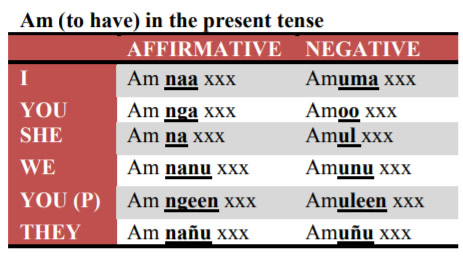Difference between revisions of "Language/Wolof/Grammar/Am-(to-have)-in-the-present-tense"
Jump to navigation
Jump to search
m (Quick edit) |
m (Quick edit) |
||
| Line 1: | Line 1: | ||
[[File:Wolof-Language-PolyglotClub.jpg|thumb]] | [[File:Wolof-Language-PolyglotClub.jpg|thumb]] | ||
<div | <div class="pg_page_title"> Am (to have) in the present tense </div> | ||
__TOC__ | __TOC__ | ||
==Conjugation== | ==Conjugation== | ||
| Line 9: | Line 9: | ||
*Am na tool bu mag ci villas bi = There’s a big field in the village | *Am na tool bu mag ci villas bi = There’s a big field in the village | ||
*Amuma jot bu doy pur dem Cees = I don’t have enough time to go to Thies | *Amuma jot bu doy pur dem Cees = I don’t have enough time to go to Thies | ||
==Notes== | ==Notes== | ||
| Line 17: | Line 16: | ||
http://publish.illinois.edu/wolof201fall14/files/2014/08/NEW_WOLOF_BOOK.pdf | http://publish.illinois.edu/wolof201fall14/files/2014/08/NEW_WOLOF_BOOK.pdf | ||
== | ==Other Lessons== | ||
* [[Language/Wolof/Grammar/Notable-characteristics|Notable characteristics]] | * [[Language/Wolof/Grammar/Notable-characteristics|Notable characteristics]] | ||
* [[Language/Wolof/Grammar/Adjectives|Adjectives]] | * [[Language/Wolof/Grammar/Adjectives|Adjectives]] | ||
| Line 27: | Line 26: | ||
* [[Language/Wolof/Grammar/The-possessive-expressed-by-“U”|The possessive expressed by “U”]] | * [[Language/Wolof/Grammar/The-possessive-expressed-by-“U”|The possessive expressed by “U”]] | ||
* [[Language/Wolof/Grammar/Possessive-pronouns|Possessive pronouns]] | * [[Language/Wolof/Grammar/Possessive-pronouns|Possessive pronouns]] | ||
<span links></span> | |||
Latest revision as of 13:07, 27 March 2023
Am (to have) in the present tense
Conjugation[edit | edit source]
Examples[edit | edit source]
- Am naa xarit yu baax ci sunu dëkk = I have good friends in in our village
- Am na tool bu mag ci villas bi = There’s a big field in the village
- Amuma jot bu doy pur dem Cees = I don’t have enough time to go to Thies
Notes[edit | edit source]
All the other static verbs can be conjugated in that way.
Source[edit | edit source]
http://publish.illinois.edu/wolof201fall14/files/2014/08/NEW_WOLOF_BOOK.pdf
Other Lessons[edit | edit source]
- Notable characteristics
- Adjectives
- Pronouns and How to ask questions
- Conditional Mood
- Future Tense
- Questions
- Plural Nouns — Definite articles
- The possessive expressed by “U”
- Possessive pronouns

